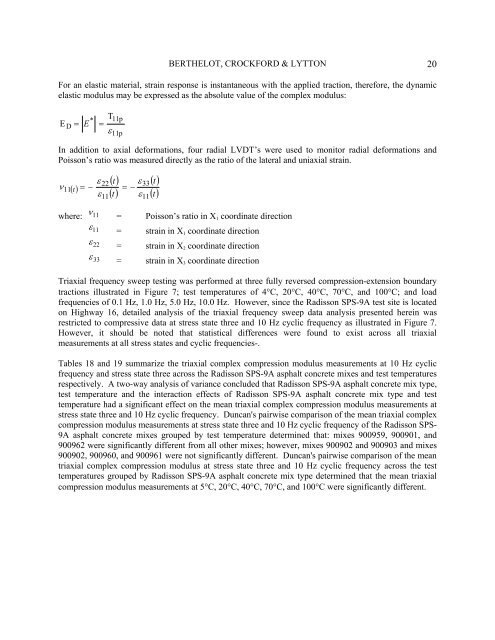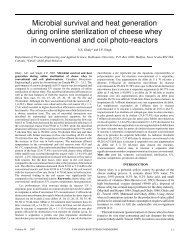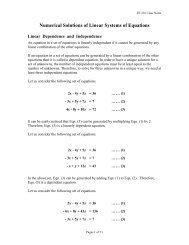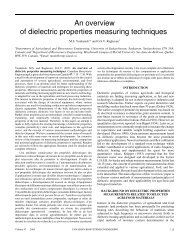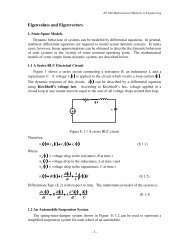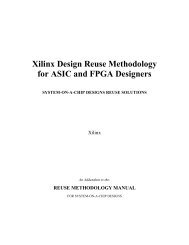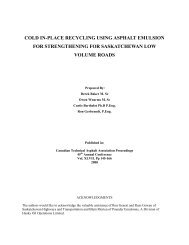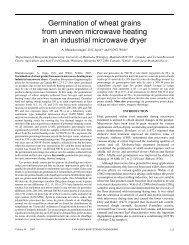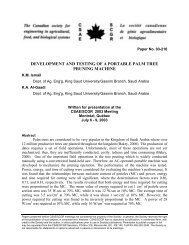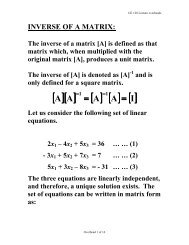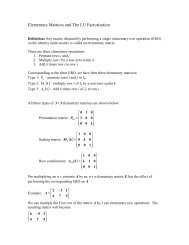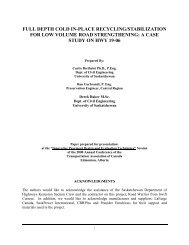comparison of alternative asphalt concrete rut characterization
comparison of alternative asphalt concrete rut characterization
comparison of alternative asphalt concrete rut characterization
You also want an ePaper? Increase the reach of your titles
YUMPU automatically turns print PDFs into web optimized ePapers that Google loves.
BERTHELOT, CROCKFORD & LYTTON 20For an elastic material, strain response is instantaneous with the applied traction, therefore, the dynamicelastic modulus may be expressed as the absolute value <strong>of</strong> the complex modulus:*E D = E=T11pε11pIn addition to axial deformations, four radial LVDT’s were used to monitor radial deformations andPoisson’s ratio was measured directly as the ratio <strong>of</strong> the lateral and uniaxial strain.ν11()t =ε−ε2211() t() t=ε−ε3311() t() twhere:ν 11 = Poisson’s ratio in Xε 11ε 22ε 331 coordinate direction= strain in X1 coordinate direction= strain in X2 coordinate direction= strain in X3 coordinate directionTriaxial frequency sweep testing was performed at three fully reversed compression-extension boundarytractions illustrated in Figure 7; test temperatures <strong>of</strong> 4°C, 20°C, 40°C, 70°C, and 100°C; and loadfrequencies <strong>of</strong> 0.1 Hz, 1.0 Hz, 5.0 Hz, 10.0 Hz. However, since the Radisson SPS-9A test site is locatedon Highway 16, detailed analysis <strong>of</strong> the triaxial frequency sweep data analysis presented herein wasrestricted to compressive data at stress state three and 10 Hz cyclic frequency as illustrated in Figure 7.However, it should be noted that statistical differences were found to exist across all triaxialmeasurements at all stress states and cyclic frequencies-.Tables 18 and 19 summarize the triaxial complex compression modulus measurements at 10 Hz cyclicfrequency and stress state three across the Radisson SPS-9A <strong>asphalt</strong> <strong>concrete</strong> mixes and test temperaturesrespectively. A two-way analysis <strong>of</strong> variance concluded that Radisson SPS-9A <strong>asphalt</strong> <strong>concrete</strong> mix type,test temperature and the interaction effects <strong>of</strong> Radisson SPS-9A <strong>asphalt</strong> <strong>concrete</strong> mix type and testtemperature had a significant effect on the mean triaxial complex compression modulus measurements atstress state three and 10 Hz cyclic frequency. Duncan's pairwise <strong>comparison</strong> <strong>of</strong> the mean triaxial complexcompression modulus measurements at stress state three and 10 Hz cyclic frequency <strong>of</strong> the Radisson SPS-9A <strong>asphalt</strong> <strong>concrete</strong> mixes grouped by test temperature determined that: mixes 900959, 900901, and900962 were significantly different from all other mixes; however, mixes 900902 and 900903 and mixes900902, 900960, and 900961 were not significantly different. Duncan's pairwise <strong>comparison</strong> <strong>of</strong> the meantriaxial complex compression modulus at stress state three and 10 Hz cyclic frequency across the testtemperatures grouped by Radisson SPS-9A <strong>asphalt</strong> <strong>concrete</strong> mix type determined that the mean triaxialcompression modulus measurements at 5°C, 20°C, 40°C, 70°C, and 100°C were significantly different.


